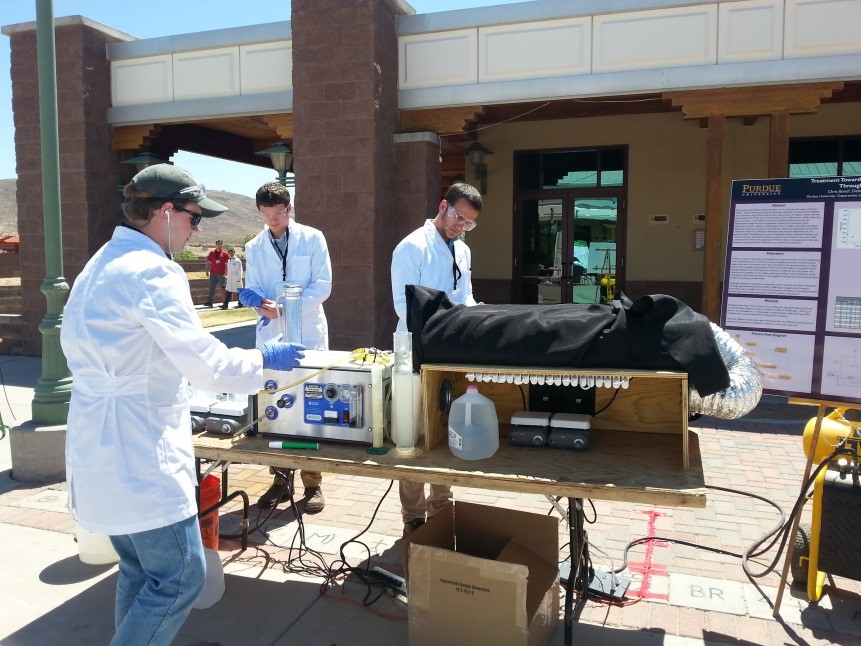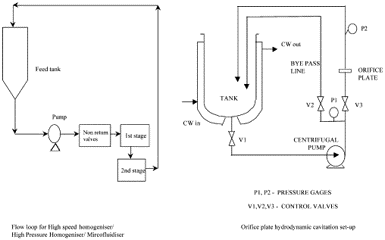2014 EEE Senior Design Projects
EEE Senior Design students attend WERC’s Environmental Design Contest


This past April, four EEE students joined hundreds of other college students from around the United States and the world in WERC’s Environmental Design Contest at New Mexico State University in Las Cruces, New Mexico.
Chris Bond, Delaney Cloyd, Aaron Crow, and Brian Otten participated in the Open Task Competition, in which they had to present a solution to a real-life environmental, energy, or water related issue. The Purdue EEE students centered their design on reducing the pollution caused by the processing of coffee beans. To showcase their solution, the team converted a semester’s worth of research into a written report, oral presentation, bench-scale demonstration, safety summary/process flow, and poster presentation.
Even though the WERC’s Environmental Design Contest did not end with an award for the Purdue team, they all walked away with a great learning experience. In addition, from the judges they received great advice on how to improve their design and career advice.
Point of Use Ozone Disinfection
Project Background

Previous Global Engineering Teams have installed several slow sand filters in elementary schools in Colombia. Although the these systems are highly effective in removing turbidity, disinfection of the filtered water is still required to make it safe for consumption. Chlorination is the most commonly used method of water disinfection, but is only moderately effective at inactivating Giardia Lamblia, a common intestinal infecting protozoa. Ozone, however, has been shown to be effective at inactivating Giardia Lamblia (EPA, 1999). Because ozone does not leave a “residual” disinfectant in the water, ozonation followed by chlorination can provide users with redundancy that provides additional safety. In these project, the Point of Use Ozone Disinfection Team will research and design a cost effective, batch, ozone disinfection system to disinfect effluent water from point-of-use slow sand filters. Kimberly-Clark and the Global Engineering Program at Purdue are project sponsors.
Project Objectives
In this Senior Design project, an ozone generator will be designed, constructed, and tested. In order to accomplish this goal, the following constraints must be met:
- The ozone generator must disinfect water to U.S. EPA and Columbia drinking water standards.
- All components used in construction must be inexpensive, yet robust.
- The unit's design must incorporate science and engineering knowledge reported in the literature.
- Operation and maintenance should be simple and safe, such that it can be used by someone with a middle school education
Value Added Effluent: The Plant
Project Background

The Plant was once a 93,500 square-foot meatpacking facility in the Chicago stockyards, and now functions as a net-zero energy vertical farm and food business operation. An anaerobic digestion system has been established to convert food and farm waste that is produced on site into energy from biogas production. The digester will consume 13 tons of food waste per day; produce 2.2 million BTU of biogas per hour, which will be captured and burned in a conversion heat pump to produce 200 kWh of electricity; and the digester effilent is estimated to consist of 1 ton per day of press-cake for composting as well as 8 tons per day of liquid soil amendment (to replace fossil fuel based fertilizer). This Anaerobic Digester system is made possible by Illinois Department of Commerce and Economic Opportunity, Chicago Community Loan Fund, Eisenmann Corporation.
Project Objectives
Typically, anaerobic digester effluent can be processed into fertilizer and used in direct land application. However, The Plant is located on the south side of Chicago, thus there is no agricultural land close enough to transport the effluent in a sustainable or economically feasible manner. The objective of this project is to find a use for the effluent produced by the anaerobic digester at The Plant in order to maximize profitability and sustainability.
WERC Design Competition

(Acoustic Cavitation)
Project Background
Natural organic matter (NOM) is on a global trend upward. The primary objective of oxidation is the generation of hydroxyl radicals. Specific UV-absorbance tests are common in the identification of NOM. NOM removal is important for the prevention of disinfection by-products (DBPs), removal of annoying color, taste, and odor, prevention of biological build-up in systems, and improvement of aquatic ecosystems (Matilainen et. al., 2010). Popular lab techniques for oxidation of organics include (Cogate, 2004): 1.Fenton oxidation, 2.Acoustic cavitation, 3.Hydrodynamic cavitation and, 4.Photocatalytic oxidation.
Project Objectives
This senior design project team is competing in the New Mexico State University's Institute for Energy and the Environment's WERC: A Consortium for Environmental Education and Technology Development competition. The senior design project team will be evaluating typical treatment approaches for the oxidation of dissolved organics and devising a test system that can be used to perform a bench scale test for a variety of organic streams. The main evaluation criteria are:
- Cost of treatment
- Applicability to multiple organic streams
- Energy efficiency
- Removal efficiency
- Ease of implementation
Once the team has selected a few appropriate technologies, they will pick and characterize (i.e. DOC, BOD, pH, specific UV-absorbance values) an organic stream to treat. Knowing the nature of our organic stream will allow us to optimize the treatment technologies being evaluated.
Indiana Dunes Historic Restoration
Project Background

The Indiana Dunes National Lakeshore is one of America’s richest historical sites. It is home to a multitude of history and historic structures. Operated by the National Park Service, it greets thousands of visitors each year. The Indiana Dunes Historic Restoration Team's role is to kick-off a long term project establishing a research relationship with IDNL and Purdue University. For the EEE design project, the primary focus will be on efficiency and sustainability of a particular site at IDNL.
Project Objectives
The short-term objective of our partnership is to propose a collection of historic buildings and fields that may be improved by application of our education here in EEE using green technologies and meeting LEED standards. Possible sites include:
- Charles Nelson Home
- Chellberg Farm
- Baily Homestead
- Goodfellow Lodge
